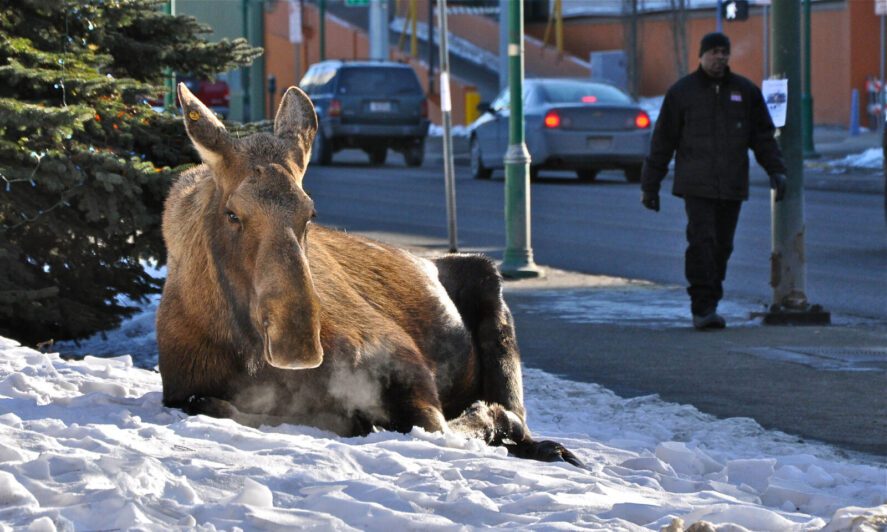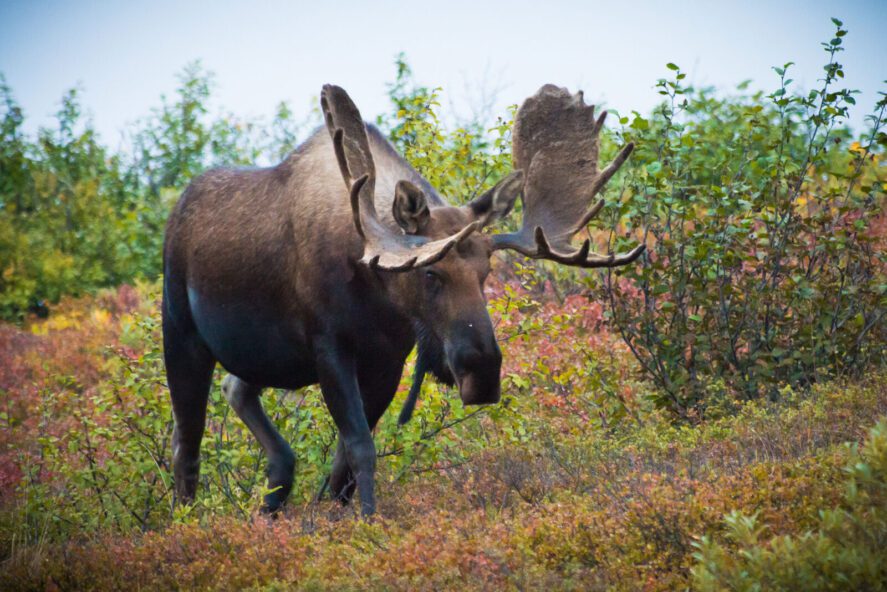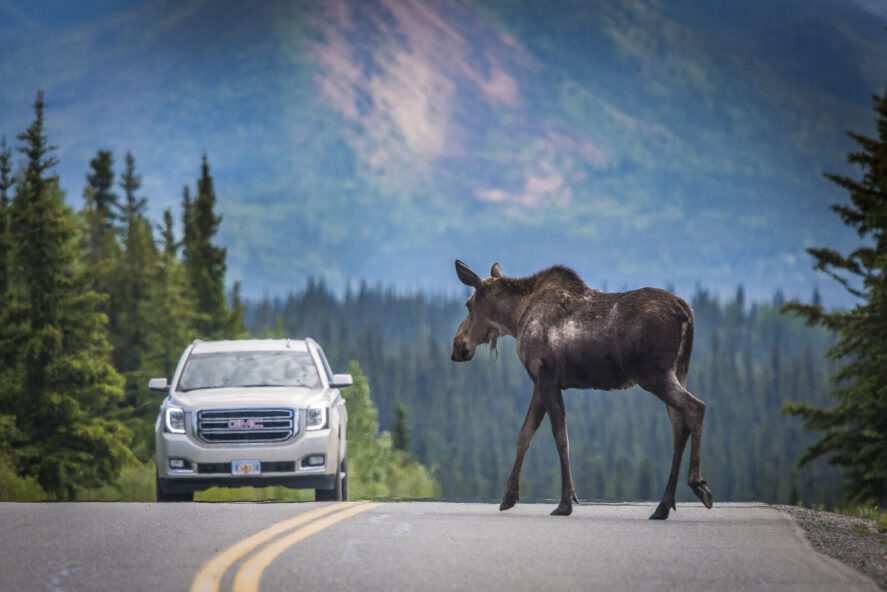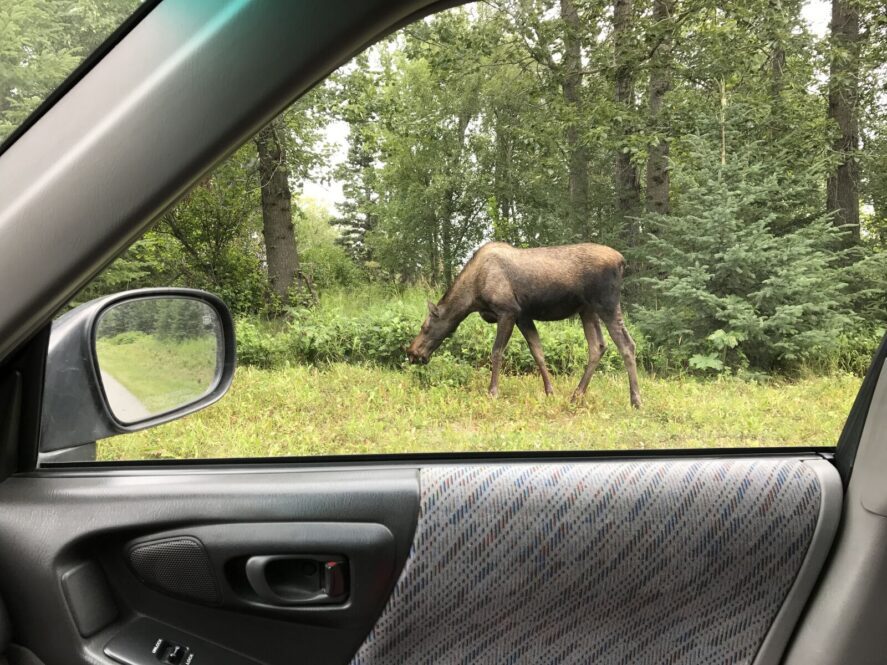No animal is more iconic to the northern woodlands and forests of North America than the moose (Alces alces). These not-so-graceful giant herbivores are prevalent all over Alaska and are considered one of “Alaska’s Big Five” among the state’s prolific wildlife, along with bears, caribou, Dall sheep and wolves. You might be excited if you spot these wonderful creatures on your Alaska trip so we thought we’d let you in on five things you should know about the celebrated moose.
#1 – Moose are Everywhere in Alaska
The first thing to know about moose in Alaska is that they are everywhere – well, almost. According to the Alaska Department of Fish & Game, moose can be found over almost the entire state, from parts of Southeast Alaska to as far north as the Arctic Slope. However, moose are most commonly encountered in the Southcentral and Interior regions, including in both Anchorage and Fairbanks.
Throughout many Alaskan cities and towns, moose have adapted to living in urban environments alongside humans. While you can certainly book an excursion into a National Park to look for moose and other wildlife, it’s also entirely possible that you may encounter moose as you explore downtown areas in whichever cities you are visiting.

Moose in Town Square Park in Anchorage (Roy Neese/Visit Anchorage)
#2 – Moose Are Here Year-Round
Most of Alaska’s famous wildlife species are visible to visitors primarily during the summer. When fall arrives, bears go into hibernation, salmon die off, and whales migrate south for the winter. Not so for moose, who are active, year-round Alaska residents. This is great news for any wildlife enthusiasts who might be considering an ‘off-season’ trip to Alaska during the fall, winter or spring.
In fact, the ‘off-season’ may actually be one of the best times to spot a moose in the wild. For moose, fall is the “rutting season” in which bull moose spar with each and compete for females. According to the National Park Service, the best time to see the moose rut in Denali is from late August to early October. Wildlife enthusiasts might consider our 8-day Autumn Highlights itinerary which includes a bus tour into Denali National Park to look for moose and other animals.
The winter season also provides great opportunities for spotting moose in Alaska, as their dark coats stand out against the fluffy white snow. Moose are also more often seen along highways or in downtown neighborhoods in the winter, as the paved roads are easier for them to walk on than in the deep snow.

Bull Moose in Denali National Park in Fall (Kent Miller/NPS)
#3 – Moose ALWAYS Have the Right-of-Way
Since moose are found throughout Alaska and are active year-round, it’s no surprise that they are commonly found wandering along city streets and major highways. This means that if you’re exploring the state on one of our self-drive tours, your vacation might include opportunities to see moose and other wildlife along Alaska’s many scenic byways. Just be aware, as you drive around the state, that you should be on the alert for moose crossing the highway when you least expect.
Do not expect moose to yield to your vehicle. According to the Alaska Department of Fish & Game, over 800 collisions between vehicles and moose occur in Alaska each year, and these collisions can be harmful or even fatal for moose and humans alike. Please, as you travel our Alaska Highway system and local roadways, keep a watch out for moose and always give them the right-of-way.

Watch for Moose! (Kent Miller/NPS)
# 4 – Moose Like Their Personal Space
Moose are solitary creatures. Unlike caribou, they prefer to live on their own, and not in large herds. Other than a mother moose with her calves or a bull moose competing for females during the rutting season, you’ll rarely see moose gathered together.
Moose like to have their personal space from humans as well. Adult moose can weigh up to 1,600 pounds, making them quite dangerous if threatened or startled. Always observe moose from a safe distance away. If you’re traveling with pets, make sure they are leashed or otherwise restrained. Most importantly, never put yourself in a situation where you could come in between a mother moose and her calves.

Moose in Kincaid Park in Anchorage (Jack Bonney/Visit Anchorage)
#5 – Moose Sightings Aren’t A Guarantee
In Alaska, like anywhere else, wildlife sightings are never guaranteed. While moose sightings are very frequent in Alaska, visitors should understand that animals in the wild come and go as they please.
However, those who want to see moose and other Alaskan animals can visit the Alaska Wildlife Conservation Center in Portage. The Center exists both as a visitor-welcoming conservation center as well as a wildlife sanctuary that takes in injured animals and provides them with quality care and spacious living room at the 200-acre center.
In addition to moose, the Center also is home to bears, wood bison, musk ox, and more. Interested in visiting the Alaska Wildlife Conservation Center? Consider taking our 8-hour Glacier and Wildlife Turnagain Arm Tour out of Anchorage.

Arnold the Moose and Staff (Alaska Wildlife Conservation Center)
Whenever you decide to make your plans to visit Alaska, we hope you’ll have a chance to spot the popular and prevalent Alaska moose somewhere on your journey
